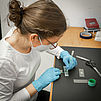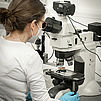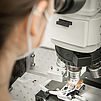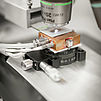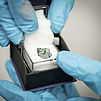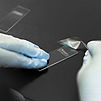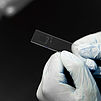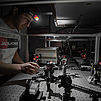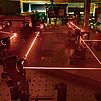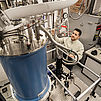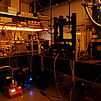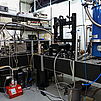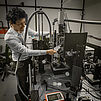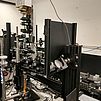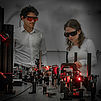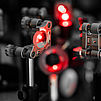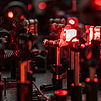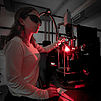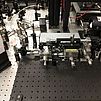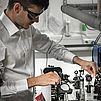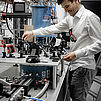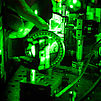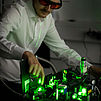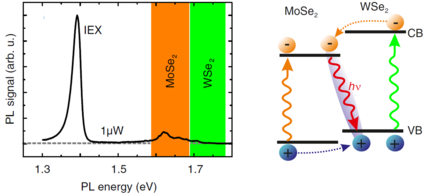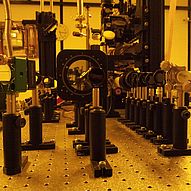
Research
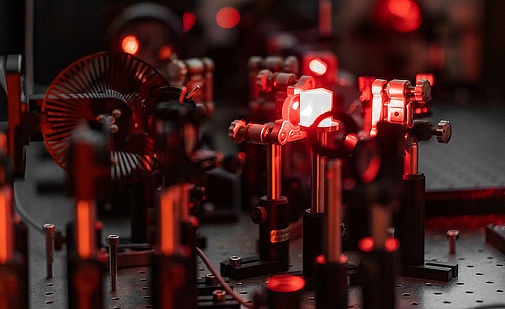
Photos: Simon Raiber
Laboratories of the group
We have five laboratories in our group. One lab for the preparation of 2D crystals and their heterostructures via mechanical exfoliation and deterministic transfer (2D Crystal Fab), and four labs for optical spectroscopy.
2D Crystal Fab
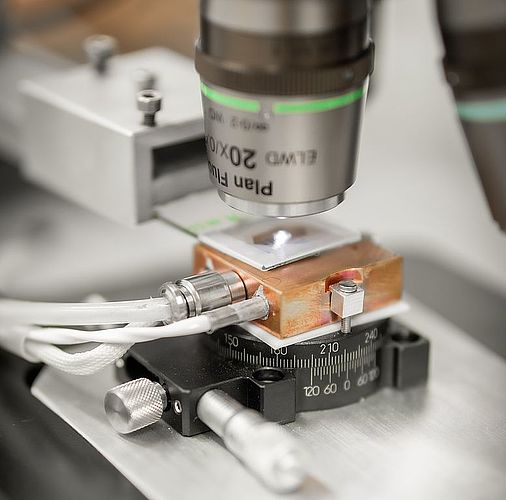
Experiments:
-
Preparation of single- and few-layer samples via mechanical exfoliation
-
Preparation of artificial hetero- or multi-layer structures via a deterministic transfer process
Pictures:
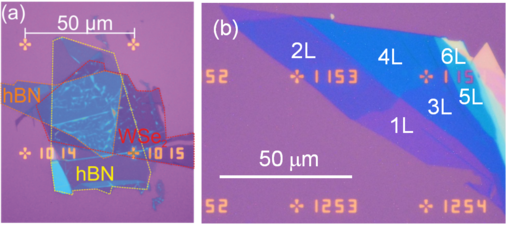
(a) Microscope image of WSe2 layer, encapsulated in hBN layers. (b) Exfoliated MoSe2 sample. The numbers of layers are indicated.
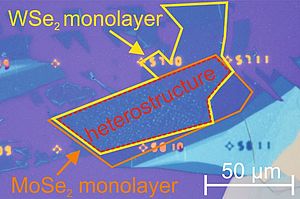
Microscope image of WSe2-MoSe2 heterostructure, prepared by deterministic transfer of single layers.
Ultrafast Spectroscopy Lab I
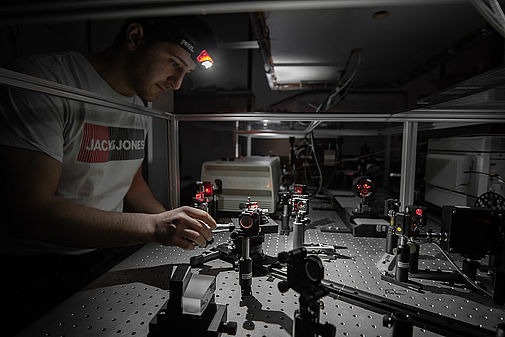
Experiments:
- Time-resolved photoluminescence with streak-camera system
2 ps maximum time-resolution, microscope setup for spatially-resolved experiments, temperatures down to 4 K - Pump-probe spectroscopy, e.g., time-resolved Faraday or Kerr rotation, four-wave mixing, with mode-locked Ti-Sapphire femtosecond laser
Pulse length 100 fs - 600 fs, wavelength range 700 nm - 830 nm, magnetic fields up to 11.5 T, temperatures down to 0.4 K - cw photoluminescence spectroscopy
Spectrometer with 0.5 m focal length and CCD camera, various laser sources, magnetic fields up to 11.5 T, temperatures down to 0.4 K
Ultrafast Spectroscopy Lab II
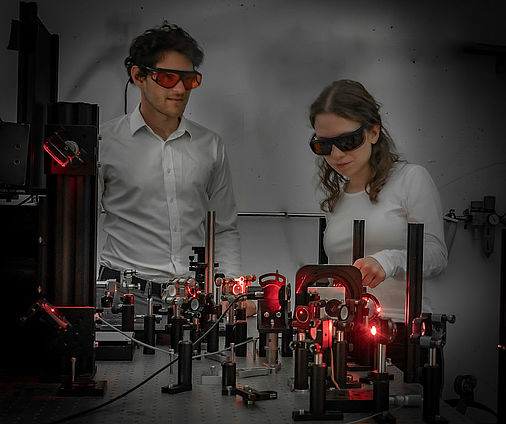
Experiments:
-
Time- and spatially resolved two-color Kerr rotation with mode-locked Ti:Sapphire laser and white-light source
Microscope setup for time- and spatially-resolved experiments, temperatures down to 4 K -
Second-harmonic generation with mode-locked Ti-Sapphire femtosecond laser
Spectrometer with 0.25 m focal length and CCD camera -
Photoluminescence and white-light reflectance
Spectrometer with 0.25 m focal length and CCD camera
Raman Lab I
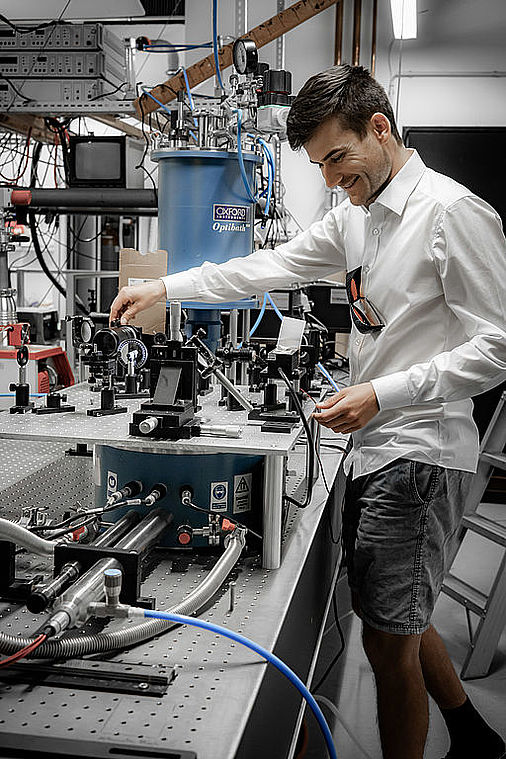
Experiments:
-
Resonant Magneto-Raman Spectroscopy
Triple Raman spectrometer with LN2-cooled CCD detector, tunable cw Ti:Sapphire laser, magnetic fields up to 9 T, temperatures down to 2 K -
Resonant Micro-Raman Spectroscopy
Microscope setup for spatially-resolved experiments, tunable cw Ti:Sapphire laser, temperatures down to 4 K
Raman Lab II
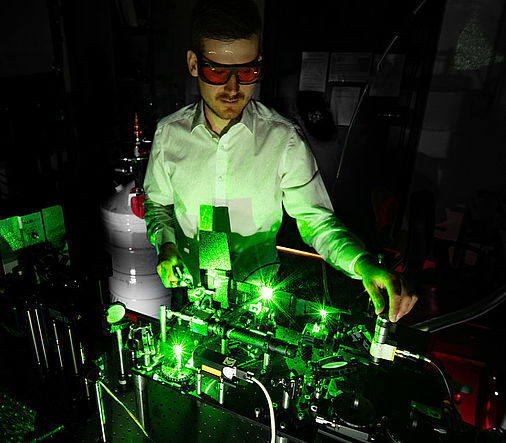
Experiments:
- Micro-Raman Spectroscopy and Mapping
Microscope setup with automated mapping option, spectrometer with 0.5 m focal length and CCD camera, Bragg filter sets for stray-light reduction, various laser sources - White-light reflectance experiments
white-light source, spectrometer with 0.5 m focal length and CCD camera
Research projects
Our projects are funded by the DFG via individual projects, the DFG Priority Program SPP2244, and within the Collaborative Research Center SFB 1277.
Exciton and valley dynamics in 2D crystals and heterostructures
We study the optical and electronic properties of monolayer transition metal dichalcogenides and a variety of heterostructures consisting of different two-dimensional materials via cw- and time-resolved optical spectroscopy. The aim is to investigate spin- and valley-polarization dynamics in monolayers, as well as the properties of interlayer excitons in heterostructures. The employed spectroscopic methods are cw- and time-resolved photoluminescence, using a streak camera system, and, time-resolved pump-probe Faraday rotation. In the focus are time-resolved studies of the spin- and valley dynamics in high magnetic fields.
|
| |
| Left: Photoluminescence spectrum of a MoSe2-WSe2 heterostructure. Right: Schematic picture of the charge separation in a type-II heterostructure and formation of the interlayer exciton (IEX). | |
Ongoing PhD projects:M. Sc. Simon Raiber M. Sc. Andreas Beer | |
Ultrafast magneto spectroscopy of van-der-Waals materials
In this project, the aim is to explore the dynamics and coherence properties of excitons and excitonic complexes in atomically thin transition-metal dichalcogenide mono- and multilayers in external magnetic fields by time-resolved Faraday rotation and time-integrated four-wave-mixing.
|
Spectrally-resolved four-wave mixing (FWM) experiment on a GaAs-AlGaAs superlattice, showing coherent Bloch oscillations. | |
|
Tim-resolved Faraday ellipticity (TRFE) experiment on a WSe2 multilayer in an in-plane magnetic field, showing pseudospin quantum beats. An artistic view of the multilayer is projected in the background. |
Ongoing PhD projects:
M. Sc. Simon Raiber
M. Sc. Anna Weindl
Resonant Raman spectroscopy of 2D crystal heterostructures
We apply the technique of low-frequency Raman scattering to a variety of hetero- and homobilayer transition-metal dichalcogenide structures. The aims are the investigation of the domain structure of atomic reconstructions in twisted heterobilayers, the low-frequency modes of correlated quantum phases in the magic-angle continuum in homobilayers, and the exploration of internal electronic excitations of excitonic complexes in heterobilayers.
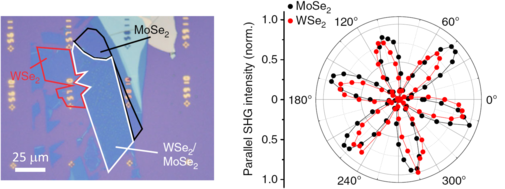
Left: Microscope picture of MoSe2-WSe2 heterostructure. Right: Second-harmonic generation experiment for the determination of the crystal orientations of the constituent layers.
Ongoing PhD projekt:
M. Sc. Philipp Parzefall
Inelastic light scattering on GaAs-AlGaAs nanostructures
In collaboration with the group of Dominique Bougeard we are investigating electronic excitations in wurtzite-phase GaAs-AlGaAs core-shell nanowires. The nanowires have core diameters down to about 20 nm and show distinct two-dimensional quantization effects. Via inelastic light scattering we are exploring the electronic excitations of photo-excited electron-hole plasmas in those quantum structures.
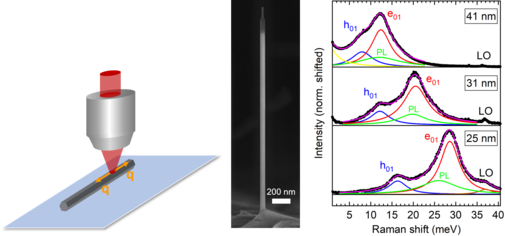
Left: Schematic picture of the Raman experiment on a single nanowire. Middle: Scanning electron microscope picture of a single nanowire. Right: Raman spectra of 3 nanowires with different diameters, as given in the figure. Intersubband excitations between size-quantized one-dimensional subbands can be observed.
Finished PhD project:
M. Sc. Sebastian Meier
